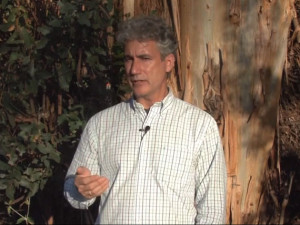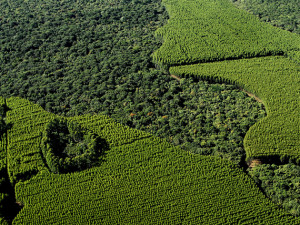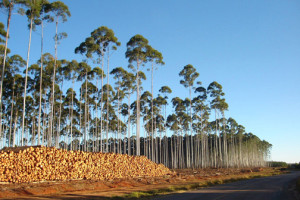From antiseptic oils to the construction of didgeridoos, the traditional Australian Aboriginal wind instrument, the eucalyptus tree serves myriad purposes, accounting for its status as one of the world’s most widely planted hardwood trees. Its prodigious growth habit has caught the eyes of researchers seeking to harness and improve upon Eucalyptus’ potential for enhancing sustainable biofuels and biomaterials production, and provide a stable year-round source of biomass that doesn’t compete with food crops.

Study author Jerry Tuskan explains why eucalyptus is of interest to bioenergy researchers in a video at http://bit.ly/eucalyptusTuskan.
Reported in the June 12, 2014 edition of the journal Nature, the international effort to sequence and analyze the 640 million base pair genome of Eucalyptus grandis engaged more than 80 researchers from 30 institutions, representing 18 countries. The project was led by Alexander Myburg of the University of Pretoria (South Africa); Dario Grattapaglia of the Brazilian Agricultural Research Corporation (EMBRAPA) and Catholic University of Brasilia; Gerald Tuskan of the Oak Ridge National Laboratory and the BioEnergy Science Center and U.S. Department of Energy Joint Genome Institute (DOE JGI); Dan Rokhsar of the DOE JGI and Jeremy Schmutz of the DOE JGI and the HudsonAlpha Institute for Biotechnology.
Trees play a significant role in the global carbon cycle. Collectively, they represent a major terrestrial repository of carbon and play both active CO2 capture and processing and passive storage roles. With these advantages in mind, Eucalyptus can be harvested from tropical and temperate zones and has over 700 species that are rich in genetic variation. Combing through the 36,000-plus genes found in Eucalyptus (nearly twice as many as in the human genome), the researchers homed in on those that may influence the production of secondary cell wall material that can be processed for pulp, paper, biomaterials and bioenergy applications. Approximately 80 percent of the woody biomass in a Eucalyptus is made of cellulose and hemicellulose, both long chains of sugars, with the remaining biomass primarily comprised of lignin, the tough “glue” that holds it all together.

Eucalyptus trees are among the most widely planted hardwood trees and serve myriad purposes. Bioenergy researchers want to harness its potential application toward sustainable biofuels production. (Roy Kaltschmidt, LBNL)
“A major challenge for achieving a sustainable energy future is our understanding of the molecular basis of superior growth and adaptation in woody plants suitable for biomass production,” said Myburg.
“Our comparative analysis of the complex traits associated with the Eucalyptus genome and other large perennials offers new opportunities for accelerating breeding cycles for sustainable biomass productivity and optimal wood quality,” noted Grattapaglia. “In addition, insights into the trees’ evolutionary history and adaptation are improving our understanding of their response to environmental change, providing strategies to diminish the negative environmental impacts that threaten many species.”
“We have a keen interest in how wood is formed,” said ORNL’s Jerry Tuskan. “A major determinant of industrial processing efficiency lies in the composition and cross-linking of biopolymers in the thick secondary cell walls of woody fibers. Our analysis provides a much more comprehensive understanding of the genetic control of carbon allocation towards cell wall biopolymers in woody plants—a crucial step toward the development of future biomass crops.”
While native to Australia, eucalyptus trees are planted worldwide mostly for the value of its wood; for the Department of Energy, their energy-rich cellulosic biomass makes them one of the principal candidate biomass energy crops. Genome sequencing is an essential diagnostic tool for understanding the basis of its superior growth properties, attributes that can be propagated to other candidate biofuel feedstock species. Because of its wide adaptability, extremely fast growth rate and excellent wood and fiber properties, Eucalyptus trees are grown in 100 countries across six continents and account for over 40 million acres.

Left to Right: Dario Grattapaglia, EMBRAPA; Zander Myburg, University of Pretoria; and Jerry Tuskan, ORNL pose in front of Eucalyptus regnans in Tasmania. These three researchers began discussing sequencing eucalyptus back in 2004. (Image courtesy of Zander Myburg)
The eucalyptus team identified genes encoding 18 final enzymatic steps for the production of cellulose and the hemicellulose xylan, both cell wall carbohydrates that can be used for biofuel production. “By tracing their evolutionary lineages and expression in woody tissues we defined a core set of genes as well as novel lignin-building candidates that are highly expressed in the development of xylem—the woody tissue that helps channel water throughout the plant—which serves to strengthen the tree,” said Myburg.
The team’s detailed analysis of the Eucalyptus genome revealed an ancient whole-genome duplication event estimated to have occurred about 110 million years ago, as well as an unusually high proportion of genes in tandem duplicate arrays. Their results, Tuskan said, highlight the major role of the phenomenon of tandem replication in shaping functional diversity in Eucalyptus and suggest that Eucalyptus may have followed an evolutionary path that highlighted specific genes for woody biomass production. By comparison, Eucalyptus has three times the number of tandem repeat genes present in poplar, the first tree sequenced (by the DOE JGI and published on the cover of the journal Science in 2006).
An additional finding by the team was that among sequenced plants to date, Eucalyptus showed the highest diversity of genes for specialized metabolites such as terpenes. These hydrocarbons serve as chemical self-defenses against pests, as well as providing the familiar aromatic essential oils used in both medicinal cough drops and for industrial processes.

For the Department of Energy, the eucalyptus tree’s energy-rich cellulosic biomass makes it one of the principal candidate biomass energy crops. Because of its wide adaptability, extremely fast growth rate and excellent wood and fiber properties, Eucalyptus trees are grown in 100 countries across six continents and account for over 40 million acres. (Image courtesy of Fibria. Photo by Capão Bonito)
“By having a library of these genes that control the synthesis of terpenes we are able to dissect which genes produce specific terpenes; then we can modify this biochemical pathway in the leaves so that we can develop the potential of Eucalyptus as an alternative source feedstock for jet fuel,” noted Tuskan.
The genetic architecture of inbreeding depression, often referred to as the converse of hybrid vigor, is largely unknown for trees and was also tackled in the study. “This poses a barrier to their rapid domestication and breeding improvements by way of self-pollination,” Grattapaglia said. “Our results in Eucalyptus suggest that cumulative effects of many small genetic variants throughout the genome are responsible for these fundamental genetic phenomena. Favorably combined, they determine the height of a tree, which is one of our gauges for overall fitness.”
The extensive catalog of genes contributed by the team will allow breeders to adapt Eucalyptus trees for sustainable energy production in regions, such as the U.S. Southeast, where it cannot currently be grown.

These are 6-year old Eucalyptus benthamii trees being harvested for power generation. Approximately 80 percent of the woody biomass in a Eucalyptus is made of cellulose and hemicellulose, both long chains of sugars, with the remaining biomass primarily comprised of lignin, the tough “glue” that holds it all together. (Image by H.D. Silva, Embrapa Forestry. Photo taken in Guarapuava / PR.)
“Eucalyptus has a truly unique evolutionary history,” Tuskan said. “This, along with its keystone ecological status and ability to adapt to marginal terrain, make Eucalyptus an excellent focus for expanding our knowledge of the evolution and adaptive biology of perennial plants.”
A short interview with Jerry Tuskan on the implications of the team’s Eucalyptus genome analysis can be viewed here: http://bit.ly/eucalyptusTuskan.
The Eucalyptus genome data are available publicly through the DOE JGI’s comparative plant genomics portal known as Phytozome, now in its 10th revision (http://bit.ly/Phytozome-Eucalyptus).